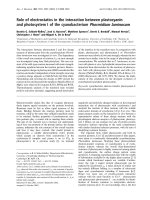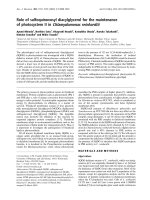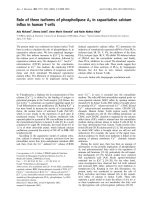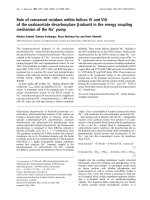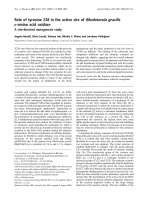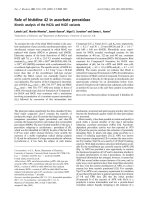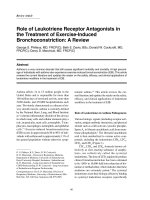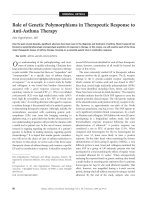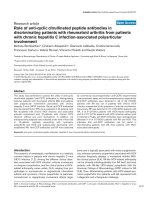Báo cáo Y học: Role of conserved residues within helices IV and VIII of the oxaloacetate decarboxylase b subunit in the energy coupling mechanism of the Na+ pump ppt
Bạn đang xem bản rút gọn của tài liệu. Xem và tải ngay bản đầy đủ của tài liệu tại đây (237.81 KB, 8 trang )
Role of conserved residues within helices IV and VIII
of the oxaloacetate decarboxylase b subunit in the energy coupling
mechanism of the Na
+
pump
Markus Schmid, Thomas Vorburger, Klaas Martinus Pos and Peter Dimroth
Mikrobiologisches Institut der Eidgeno
¨
ssischen Technischen Hochschule, ETH-Zentrum, Zu
¨
rich, Switzerland
The membrane-bound b subunit of the oxaloacetate
decarboxylase Na
+
pump of Klebsiella pneumoniae catalyzes
the decarboxylation of enzyme-bound biotin. This event is
coupled to the transport of 2 Na
+
ions into the periplasm
and consumes a periplasmically derived proton. The con-
necting fragment IIIa and transmembrane helices IV and
VIII of the b subunit are highly conserved, harboring resi-
dues D203, Y229, N373, G377, S382, and R389 that play a
profound role in catalysis. We report here detailed kinetic
analyses of the wild-type enzyme and the b subunit mutants
N373D, N373L, S382A, S382D, S382T, R389A, and
R389D.
In these studies, pH profiles, Na
+
binding affinities, Hill
coefficients, V
max
values and inhibition by Na
+
was deter-
mined. A prominent result is the complete lack of oxalo-
acetate decarboxylase activity of the S382A mutant at
Na
+
concentrations up to 20 m
M
and recovery of significant
activities at elevated Na
+
concentrations (K
Na
% 400 m
M
at
pH 6.0), where the wild-type enzyme is almost completely
inhibited. These results indicate impaired Na
+
binding to
the S382 including site in the S382A mutant. Oxaloacetate
decarboxylation by the S382A mutant at high Na
+
con-
centrations is uncoupled from the vectorial events of Na
+
or
H
+
translocation across the membrane. Based on all data
with the mutant enzymes we propose a coupling mechanism,
which includes Na
+
binding to center I contributed by D203
(region IIIa) and N373 (helix VIII) and center II contributed
by Y229 (helix IV) and S382 (helix VIII). These centers are
exposed to the cytoplasmic surface in the carboxybiotin-
bound state of the b subunit and become exposed to the
periplasmic surface after decarboxylation of this compound.
During the countertransport of 2 Na
+
and 1 H
+
Y229 of
center II switches between the protonated and deprotonated
Na
+
-bound state.
Keywords: oxaloacetate decarboxylase; Na
+
pump; kinetics;
coupling mechanism.
Oxaloacetate decarboxylase of Klebsiella pneumoniae is a
particularly well-characterized member of the sodium ion
transport decarboxylase family of enzymes, which also
includes methylmalonyl-CoA decarboxylase, malonate
decarboxylase and glutaconyl-CoA decarboxylase from
various anaerobic bacteria (reviewed in [1–4]). Oxaloacetate
decarboxylase is composed of three different subunits a
(OadA), b (OadB), and c in a 1 : 1 : 1 stoichiometry [5,6].
The peripheral a subunit (63.5 kDa) harbors the carboxyl-
transferase site in its N-terminal domain and the biotin
prosthetic group in its C-terminal domain [7]. The b subunit
(44.9 kDa) is a highly hydrophobic integral membrane
protein that catalyzes Na
+
transport coupled to the
decarboxylation of carboxybiotin [8]. The c subunit
(8.9 kDa) is anchored in the membrane with an N-terminal
a helix. It has a hydrophilic C-terminal domain that binds
Zn
2+
and accelerates the carboxyltransfer reaction [9,10].
The reaction cycle is initiated with the Na
+
- independent
transfer of the carboxyl moiety from position 4 of oxalo-
acetate to the prosthetic biotin group with the participation
of the a and the c subunit (Eqn 1). Subsequently, the
carboxybiotin moiety switches to the decarboxylase site on
the b subunit and is decarboxylated under consumption of a
periplasmically derived proton and translocation of two
Na
+
ions into this compartment across the membrane
(Eqn 2) [11].
Oxaloacetate
2À
þ E-biotin $ E-biotin-CO
À
2
þ pyruvate
À
ð1Þ
E-biotin-CO
À
2
þ H
þ
out
þ 2Na
þ
in
$ E-biotin þ CO
2
þ 2Na
þ
out
ð2Þ
Insights into the coupling mechanism require structural
information about the b subunit and identification of the
essential amino acid residues. A topological model based
on fusion analyses with alkaline phosphatase and
b-galactosidase as well as cysteine accessibility studies is
shown in Fig. 1 [12]. The protein is proposed to fold into
an N-terminal block of three membrane-spanning a helices
and a C-terminal block of six membrane-spanning
a helices. The fragment (IIIa) connecting the two blocks
of helices contains mostly hydrophobic residues. It is
Correspondence to P. Dimroth, Mikrobiologisches Institut der
Eidgeno
¨
ssischen Technischen Hochschule, ETH-Zentrum,
Schmelzbergstrasse 7, CH-8092 Zu
¨
rich, Switzerland.
Fax: + 41 1632 13 78, Tel.: + 41 1632 33 21,
E-mail:
Abbreviations: OadA, oxaloacetate decarboxylase asubunit; OadB,
oxaloacetate decarboxylase b subunit; OadG, oxaloacetate
decarboxylase c subunit.
(Received 10 December 2001, revised 22 April 2002,
accepted 2 May 2002)
Eur. J. Biochem. 269, 2997–3004 (2002) Ó FEBS 2002 doi:10.1046/j.1432-1033.2002.02983.x
proposed to insert into the membrane from the periplasm
but without emerging from it into the cytoplasmic
reservoir. The connecting fragment (IIIa) and transmem-
brane helices IV and VIII comprise the most highly
conserved areas of the molecule, and within these areas
D203, Y229, N373, G377, S382 and R389 have a
profound functional role [13,14]. A model has been
envisaged where these residues, except G377, constitute a
network of ionizable groups promoting the translocation
of Na
+
ions and the oppositely oriented translocation of
H
+
across the membrane [3,13,14]. An essential feature in
the proposed mechanism is the binding of 2 Na
+
ions
from the cytoplasm at D203 and S382 including sites and
their delivery into the periplasm as a proton enters the
channel from this site and passes through it towards
carboxybiotin where it is consumed in the decarboxylation
of this acid-labile compound.
In this communication we performed detailed kinetic
analyses of various mutants in OadB, allowing us to
propose that S382 acts as a Na
+
binding ligand but is not
involved in the proton pathway through the membrane. For
proton translocation the phenolic hydroxyl of Y229 appears
to switch between the protonated and the deprotonated
state.
EXPERIMENTAL PROCEDURES
Bacterial strains and plasmids
Escherichia coli DH5a (Bethesda Research Laboratories)
and Escherichia coli BL21(DE3) (Novagen) were routinely
grown at 37 °C in Luria–Bertani medium [15]. Strains
transformed with the plasmid pET-GAB [16] were inocu-
lated with 1% of an overnight culture and aerated on a
rotary shaker at 37 °C until D
600
¼ 0.6. Isopropyl-
b-
D
-thiogalactoside was then added to a final concentration
of 0.5 m
M
and cells were grown for another 4 h at 30 °C
before harvest. E. coli EP432 [17] was grown as described
previously [13]. The antibiotics ampicillin and kanamycin
were used at a concentration of 100 lgÆmL
)1
and
50 lgÆmL
)1
, respectively.
Recombinant DNA techniques
Standard recombinant DNA techniques were performed
essentially as described by Sambrook et al.[15].PCRswere
performed using Vent DNA polymerase from New England
Biolabs (Beverly, MA, USA). Oligonucleotides used for
mutagenesis were custom-synthesized by Microsynth (Balg-
ach, Switzerland). All inserts derived from PCR and ligation
sites were checked by DNA sequencing according to the
dideoxynucleotide chain-termination method [18] using
a Taq Dye-Dideoxy Terminator Cycle Sequencing Kit
and the ABI PRISM 310 genetic analyzer from Applied
Biosystems.
Construction of mutant N373D and double mutant
N373D/D203N in the b subunit
The PCR fragment containing the mutation N373D was
constructed in a two-step protocol. For the PCR fragment
encoding the N-terminal part of the bsubunit, primers
Kpn2Ifor (5¢-GCTTCGGCGGCCTGCTCTCC-3¢)and
N373Drev (5¢-AGCCGATCAGCGGATCGATTTTGTG
CCGG-3¢) were used. For the PCR fragment encoding the
corresponding C-terminal part, primers Bstrev10800
(5¢-GGCAAACCAGTGGGTGATTTTTCG-3¢)and
N373Dfor (5¢-CCGGCACAAAATCGATCCGCTGATC
GGCT-3¢) were used. For the single mutant N373D and
double mutant D203N/N373D, pSK-GAB [10] and pSK-
GABD203N [11] served as template, respectively. The
purified PCR fragments were used as template for a second
PCR using primers Kpn2Ifor and Bstrev10800. The result-
ing fragment was subsequently digested with Kpn2Iand
Bst1107I and cloned into plasmid pSK-GAB, digested with
the same enzymes, yielding plasmids pSK-GABN373D and
pSK-GABD203NN373D.
Purification of oxaloacetate decarboxylase mutants
Oxaloacetate decarboxylase mutants were purified by
affinity chromatography of a solubilized membrane extract
on a SoftLink monomeric avidin–Sepharose column
(Promega). Large-scale purification was performed accord-
ing to [19] but using 20 m
M
Tris/HCl pH 8.0, 50 m
M
KCl as
buffer A and adding 20% glycerol to all buffers used
following sedimentation of membrane vesicles. Enzyme was
eluted in buffer A containing 5 m
M
biotin.
Determination of oxaloacetate decarboxylase activity
at various Na
+
concentrations and pH values
The decarboxylase activities of wild-type (E. coli
BL21(DE3)/pET-GAB) and mutant oxaloacetate decar-
boxylases were measured at pH values ranging between
pH 4.5 and 11 in a 20 m
M
Mes/Mops/Tris buffer system.
pH was adjusted with HCl or KOH and [Na
+
] was adjusted
by addition of NaCl. Aliquots of the enzymes used for
kinetic measurements were frozen once in liquid nitrogen
and thawed on ice shortly before starting the measurements.
The pH dependence of oxaloacetate decarboxylase activity
was determined first. If the amount of enzyme derived from
one purification batch was not sufficient for all measure-
ments within the kinetic datasets, we used different enzyme
preparations, which resulted in slight deviations in the V
max
(UÆmg
)1
) values measured. The coupled spectrophotometric
assay with lactate dehydrogenase was used to measure
oxaloacetate decarboxylase activity as described previously
[19]. The assay mixture (1 mL at 25 °C) contained 20 m
M
Tris/Mes/Mops (pH adjusted with KOH or HCl), 0.3 m
M
di-potassium NADH, 1 m
M
oxaloacetate, 3 U lactate
Fig. 1. Topology model of the b subunit emphasizing functionally
important amino-acid residues.
2998 M. Schmid et al. (Eur. J. Biochem. 269) Ó FEBS 2002
dehydrogenase and NaCl as indicated. The reaction was
started by addition of 5–200 lL of purified oxaloacetate
decarboxylase. Routinely, three kinetic datasets were col-
lected for each mutant (below, around and above the pH
optimum determined from the initial pH screening meas-
urement described above). Experimental data were fitted to
the Michaelis–Menten equation representing hyperbolic
substrate dependence of the initial velocity:
v
0
¼ V
max
½S=ð½SþK
m
Þ
Cooperative kinetic behavior with sigmoid substrate
dependence is described by the Hill equation without
substrate inhibition:
v
0
¼ V
max
½S
n
=ð½S
n
þ K
n
Þ
where v
0
represents the initial velocity; V
max
, the maximal
velocity; [S], the tested Na
+
concentration; K
m
,theMicha-
elis–Menten constant; K,theNa
+
concentration required
for half-maximal velocity; and n, the Hill coefficient
describing the dimension of cooperativity. Experimental
data for the inhibitory effect of Na
+
werefittedtoan
exponential decay.
Effect of Na
+
on tryptic hydrolysis of the oxaloacetate
decarboxylase b subunit
Protection from proteolytic digestion of the b subunit by
Na
+
ions was determined for the mutants N373D, N373L
and S382A as described previously [13]. The NaCl and KCl
concentrations used for mutant N373D were 40 m
M
,for
N373L 300 m
M
and for S382A 600 m
M
.
Labeling of oxaloacetate decarboxylase and mutant
enzymes with
14
CO
2
from [4-
14
C]oxaloacetate
[4-
14
C]Oxaloacetate, prepared from [4-
14
C]
L
-aspartate and
2-oxoglutarate with glutamate:oxaloacetate transaminase,
was used to measure the transfer of the radioactive carboxyl
residue from [4-
14
C]oxaloacetate to the biotin located on the
a subunit as described previously [13].
Reconstitution of wild-type and bS382A oxaloacetate
decarboxylase into liposomes and [
14
C]acetate uptake
measurements
Reconstitution of oxaloacetate decarboxylase was per-
formed as described [11], but with 10 m
M
Tris/HCl
pH 7.2, 5 m
M
MgCl
2
as reconstitution buffer. The decar-
boxylation reaction was started by addition of 2 m
M
oxaloacetate, and samples were removed after 20 min,
filtered and analyzed by liquid scintillation counting.
In vivo
screening of mutant oxaloacetate
decarboxylases for Na
+
pump activity
E. coli EP432 was transformed with plasmids harbouring
mutant oxaloacetate decarboxylase genes and plated on
glucose minimal medium containing 360 m
M
NaCl as
described previously [13]. As a negative control, E. coli
EP432 harbouring pSK was used. The synthesis of an active
oxaloacetate decarboxylase Na
+
pump resulted in the
formation of colonies, whereas E. coli EP432 harbouring
pSK could not sustain growth.
Analytical procedures
The protein content of samples was determined according to
the bicinchoninic acid method [20] with BSA as standard.
RESULTS
Synthesis, purification and analysis of wild-type
and mutant oxaloacetate decarboxylases in
E. coli
To synthesize mutant oxaloacetate decarboxylases, mutated
DNA fragments were cloned into pSK-GAB [10] and used
to transform E. coli DH5a as described under Experimental
procedures. For the expression of wild-type oxaloacetate
decarboxylase genes, pET-GAB [16] was used to transform
E. coli BL21(DE3). There were no differences detectable in
wild-type enzyme characteristics derived from recombinant
E. coli or from K. pneumoniae grown anaerobically on
citrate (data not shown). The synthesis of stable decarb-
oxylase complexes containing the three subunits a, b and c
was verified for all mutants after affinity purification by
SDS/PAGE. A selection of these analyses is shown in
Fig. 2.
Kinetic analysis of the wild-type enzyme
We have reported recently that the initial velocity of
oxaloacetate decarboxylation has sigmoidal dependence on
Fig. 2. SDS/PAGE analysis of a selection of mutant oxaloacetate
decarboxylases synthesized in E. coli and purified by avidin–Sepharose
chromatography. Mutations in OadB are indicated. WT, wild-type
enzyme; M, marker proteins with molecular masses shown (in kDa).
a, b and c denote the three subunits of oxaloacetate decarboxylase.
Ó FEBS 2002 Mechanism of oxaloacetate decarboxylase (Eur. J. Biochem. 269) 2999
Na
+
concentration at pH 5.5 (n
H
¼ 1.8). These results
have now been confirmed and extended by measuring the
kinetics at different pH values (Table 1 and Fig. 3). The pH
optimum of the enzyme was between pH 6.3 and 6.9.
Interestingly, the affinity of the enzyme for Na
+
increased
approximately twofold on increasing the pH from 5.6 to 6.9
or 8.3 and simultaneously the Hill coefficient dropped from
1.7 to 1.1. At Na
+
concentrations ‡ 100 m
M
,theenzymeis
markedly inhibited. The inhibition was most pronounced at
pH 8.3, where 87 m
M
Na
+
reduced the activity to one half,
whereas approximately twice this Na
+
concentration is
required to elicit the same effect at pH 6.8 or 5.6,
respectively.
Kinetic analyses of N373 mutants
Asparagine 373 is located in helix VIII close to the
periplasmic surface (Fig. 1). Its previously proposed role
as a Na
+
binding ligand has now been analyzed by kinetic
studies with the N373D and N373L mutants. The pH
profile of both mutants resembles that of the wild-type
enzyme (Fig. 3). The N373D mutant has about 20–30% of
the wild-type activity and requires 7–20 times higher Na
+
concentrations for half maximal saturation.
In the N373L mutant the specific oxaloacetate decar-
boxylase activity is dramatically reduced to about 1–3% of
the wild-type enzyme, and the Na
+
concentration required
for half maximal saturation increases approximately 200-
fold. This behavior is clearly compatible with the function of
N373 as a Na
+
binding ligand. Sodium ions may still bind
to the N373L mutant through coordination to the other
ligands of the binding site (center I), but the binding
becomes much weaker as emphasized by the dramatic
increase of the Na
+
ion concentration required to saturate
the enzyme. Both mutant decarboxylases were inhibited by
Na
+
, and the concentrations required for inhibition
increased in parallel to the Na
+
concentrations required
to saturate the enzyme. A change in Na
+
binding charac-
teristics of the mutants became also apparent from tryptic
digestion experiments. Whereas the half time for the
proteolysis of wild-type OadB was 12 h in the absence
and>24hinthepresenceof50m
M
NaCl, the digestion
half time for the N373D and N373L mutants decreased to
less than 1 h without any protection by up to 300 m
M
NaCl.
Table 1. Effects of OadB mutations on Na
+
binding characteristics, inhibition characteristics and pH profiles. Experiments were carried out as
described under Experimental procedures. K[Na]: sodium ion concentration (m
M
) required for halfmaximal activation; K
i
[Na]: sodium ion
concentration (m
M
) required for halmaximal inhibition of the enzyme.
Mutant pH-optimum Hill coefficient n
H
K [Na] V
max
(UÆmg
)1
) K
i
[Na]
Wild-type 6.25–6.75
pH 5.6 1.67 ± 0.13 1.12 ± 0.06 8.2 ± 0.2 142 ± 6
a
pH 6.9 1.06 ± 0.06 0.50 ± 0.04 15.6 ± 0.5 198 ± 18
pH 8.3 1.17 ± 0.07 0.46 ± 0.03 8.8 ± 0.3 87 ± 6
N373D 6.5
pH 5.6 1.20 ± 0.04 7.85 ± 0.35 3.32 ± 0.08 289 ± 24
pH 6.55 1.38 ± 0.05 4.05 ± 0.15 3.06 ± 0.04 231 ± 7
pH 8.17 1.53 ± 0.15 10.1 ± 1.0 2.17 ± 0.13 289
b
N373L 6.5–7.5
pH 6.25 1.26 ± 0.11 208 ± 31 0.25 ± 0.02 770 ± 96
pH 7.2 1.84 ± 0.25 123 ± 11 0.22 ± 0.01 693 ± 77
pH 8.15 1.74 ± 0.14 83.5 ± 6.0 0.09 ± 0.01 365 ± 68
c
S382A 6.3–7.8
pH 5.95 1.13 ± 0.11 424 ± 115 1.84 ± 0.27 ND
pH 7.25 1.37 ± 0.07 240 ± 42 0.84 ± 0.10 990
pH 8.4 1.51 ± 0.07 91.6 ± 3.7 0.99 ± 0.02 ND
S382D 5.8–7.4
pH 5.5 1.33 ± 0.08 2.21 ± 0.12 1.13 ± 0.03 224 ± 7
pH 6.4 1.24 ± 0.03 0.95 ± 0.02 1.47 ± 0.01 210 ± 14
pH 8.5 1.35 ± 0.08 0.71 ± 0.04 0.67 ± 0.01 66 ± 6
d
S382T 6.8–8.0
pH 5.6 1.56 ± 0.11 5.02 ± 0.26 0.25 ± 0.01 630 ± 63
pH 7.3 1.19 ± 0.08 3.00 ± 0.22 0.16 ± 0.01 462 ± 33
pH 8.3 1.26 ± 0.07 1.94 ± 0.11 0.39 ± 0.01 198 ± 59
pH 9.0 1.56 ± 0.19 1.27 ± 0.10 0.19 ± 0.01 88 ± 15
R389A 9.2
pH 8.2 1.15 ± 0.06 17.7 ± 1.4 0.42 ± 0.01 693 ± 77
pH 9.1 1.09 ± 0.03 5.8 ± 0.37 1.07 ± 0.02 231 ± 8
pH 9.7 1.09 ± 0.07 2.3 ± 0.2 0.81 ± 0.03 105 ± 9
R389D 6.3
pH 5.6 1.11 ± 0.10 13.9 ± 1.3 0.07 1155 ± 231
pH 6.3 1.02 ± 0.09 18.3 ± 2.1 0.23 2310
pH 7.2 1.23 ± 0.06 15.9 ± 0.7 0.12 2310
a
pH 5.4;
b
pH 8.24;
c
pH 8.2;
d
pH 8.6.
3000 M. Schmid et al. (Eur. J. Biochem. 269) Ó FEBS 2002
To test for Na
+
translocating activities, the mutant
plasmids were transformed into E. coli EP432. Without a
Na
+
translocating decarboxylase, this strain is unable to
grow in presence of 360 m
M
NaCl because both Na
+
/H
+
antiporters are lacking [13]. After transformation of E. coli
EP432 with either of the mutant plasmids, growth in the
presence of 360 m
M
NaCl was observed, demonstrating the
Na
+
translocation by oxaloacetate decarboxylases with
N373D or N373L mutations in the b subunit.
As D203 and N373 have been implicated to contribute
Na
+
binding ligands to the center I site, a D203N/N373D
double mutant was constructed. No oxaloacetate decarb-
oxylase activity was found in this mutant and no Na
+
translocating activity was detectable in vivo with the
complementation assay with E. coli EP432. Consequently,
the [
14
C]carboxybiotin enzyme intermediate was accumu-
lated upon incubation with [4-
14
C]oxaloacetate (not shown).
The mutant enzyme therefore contained an intact carboxyl-
transferase and an impaired carboxybiotin decarboxylase
activity.
Kinetic analyses of S382 mutants
It has been shown previously, that the S382T and S382D
mutants are catalytically active oxaloacetate decarboxylase
Na
+
pumps [13]. These mutations, therefore do not affect
the basic catalytic mechanism of the Na
+
pump, but they
result in 10- to 20-fold lower oxaloacetate decarboxylase
activities compared to the wild-type enzyme (Table 1). The
affinities for Na
+
are also reduced compared to the wild-
type. Increasing Na
+
affinities at increasing pH and
decreasing Na
+
concentrations for half maximal inhibition
with increasing pH indicates improved Na
+
binding at
elevated pH values. The S382D mutant has a similar pH
optimum as the wild-type, whereas that of the S382T
mutant is shifted by about 1 U towards the alkaline range,
and both mutants have Hill coefficients above 1.
The S382A mutant has been described to possess no
oxaloacetate decarboxylase activity based on measurements
at pH 7.5 and 20 m
M
NaCl [13]. While these results could
be fully confirmed, we found significant oxaloacetate
decarboxylase activities for this mutant at very high Na
+
concentrations. The enzyme became half saturated at about
400 m
M
NaCl at pH 6.0, at 240 m
M
NaCl at pH 7.3 and at
92 m
M
NaCl at pH 8.4, respectively. The specific activity
was 1.8 UÆmg
)1
protein at pH 6.0 and dropped to about
half at higher pH values. Hence, the enzyme with the S382A
mutation in OadB is about as active as that with the S382D
mutation but requires approximately 200 times higher Na
+
concentrations for this activity. The decarboxylase with the
S382A mutation retained positive cooperativity with respect
to Na
+
with Hill coefficients increasing from 1.1 at pH
6.0–1.5 at pH 8.4, and molar Na
+
concentrations were
inhibitory. These results implicate that the Na
+
binding of
the decarboxylase (K
m
% 1m
M
) was dramatically affected
by the S382A mutation. We also investigated the stability of
OadB with the S382A mutation in the presence of trypsin.
This mutant enzyme was degraded by trypsin with a half
time of < 1 h without or with up to 600 m
M
NaCl present,
indicating that by this mutation OadB adopts a conforma-
tion that is more susceptible to proteolysis than the wild-
type.
To investigate whether the Na
+
translocating activity
was retained in the S382A mutant, E. coli EP432 was
transformed with plasmid pSK-GABS382A. The trans-
formants were unable to grow at 360 m
M
NaCl, indicating
that no Na
+
pump was synthesized in these cells. These
results therefore suggested that the S382A mutation created
an uncoupled phenotype. Direct measurements of Na
+
uptake were not possible at the high Na
+
concentrations
required for the activity of the enzyme, but as the coupled
enzyme catalyzes the countertransport of 2 Na
+
against
1H
+
, we measured H
+
extrusion from proteoliposomes
containing the mutant decarboxylase by [1-
14
C]acetate
uptake [11]. The proteoliposomes catalyzed oxaloacetate
decarboxylation in the presence of 200 m
M
NaCl but no
accumulation of [1-
14
C]acetate in the interior compartment
and hence no proton transport from the inside of the
proteoliposomes to the outside. Accumulation of
[1-
14
C]acetate, however, was found in controls with the
wild-type enzyme. These results thus indicate that the
S382A mutation severely affects the Na
+
binding affinity so
that very high Na
+
concentrations are required to activate
the enzyme and furthermore that the oxaloacetate decarb-
oxylase activity becomes uncoupled from the vectorial Na
+
and H
+
transport across the membrane.
Mutants R389A and R389D
Arginine 389 is located in helix VIII near the cytoplasmic
surface (Fig. 1) where it has been suggested to be involved in
proton transfer to carboxybiotin, thereby initiating the
decarboxylation of this acid-labile compound [13,14]. Here,
we analyzed the mutants R389A and R389D kinetically.
Both mutants performed oxaloacetate decarboxylation,
albeit with considerably lower activities than the wild-type
enzyme. Decarboxylation was coupled to Na
+
transport
across the membrane, as indicated by the growth of
Fig. 3. Dependence of oxaloacetate decarboxylase activity on pH. The
different mutants are indicated in the box on the top right. The scale
for the velocity of the mutants is indicated on the left side and that
for the wild-type enzyme on the right side. The assay conditions are
described under experimental procedures.
Ó FEBS 2002 Mechanism of oxaloacetate decarboxylase (Eur. J. Biochem. 269) 3001
appropriately transformed E. coli EP432 in the presence of
360 m
M
NaCl. The most dramatic effect of the R389A
mutant is a shift of the pH optimum by more than 2.5 pH
units to the alkaline compared to the wild-type. This shift in
the pH optimum is accompanied by a drastic 35-fold
decrease of the Na
+
affinity (at pH 8.2–8.3) and an
eightfold increase of the Na
+
concentration required for
half maximal inhibition. Upon further increasing the pH,
the Na
+
affinity of the mutant decarboxylase increases and
the Na
+
concentration causing half maximal inhibition
decreases. The R389D mutant has the same pH optimum as
the wild-type but requires more than 10 times higher Na
+
concentrations for activating or inhibiting the enzyme. A
pronounced cooperativity with respect to Na
+
binding is
not observed for the R389A or R389D mutants.
Mutants Y229F, Y229A, and D203N
The unexpected oxaloacetate decarboxylase activity of the
S382A mutant at high Na
+
concentrations (>100 m
M
,see
above) prompted us to investigate whether the mutants
Y229F and D203N, which are inactive in the presence of
20 m
M
NaCl, exhibited activities at elevated Na
+
concen-
trations. However, no activity was found for these mutants
up to 600 m
M
NaCl and at various pH values. Hence, Y229
and D203 are crucial residues for the decarboxylase activity
of the enzyme. Traces of oxaloacetate decarboxylase activity
(0.02 UÆmg
)1
at pH 7.5, 20 m
M
NaCl) have recently been
reported for the Y229A mutant [14]. This activity was
apparently not sufficient to support growth of appropriately
transformed E. coli EP432 in the presence of 360 m
M
NaCl
in liquid culture. However, if these bacteria were used to
inoculate agar plates containing 360 m
M
NaCl, growth in
colonies was observed indicating that this mutant decar-
boxylase retains coupling to Na
+
translocation albeit at a
very low rate.
DISCUSSION
In the mechanistic model shown in Fig. 4, we propose that
carboxybiotin formed at the carboxyltransferase site of the
enzyme switches to the decarboxylase site on OadB where it
forms a stable complex, possibly with the side chain of
R389, at the cytoplasmic surface of helix VIII. This would
be reasonable because helix VIII seems to align the Na
+
and H
+
conducting channel (see below) and because H
+
moving through this channel must reach the carboxybiotin
to catalyze decarboxylation. In the initial step of our model
Fig. 4. Model for coupling Na
+
and H
+
movements across the membrane to the decarboxylation of carboxybiotin. The model shows the approximate
location of important residues of helix IV, helix VIII and of region IIIa of the b subunit. Also shown is the participation of these residues in the
vectorial and chemical events of the Na
+
pump. (A) shows the empty binding site region with enzyme-bound carboxybiotin (B-COO
–
), exposing
the Na
+
binding sites toward the cytoplasm. (B) shows the situation where the first Na
+
binding site at the D203/N373 pair (center I) has been
occupied and the second Na
+
enters the Y229/S382 site (center II) with the simultaneous release of the proton from the hydroxyl side chain of
tyrosine 229. This displacement may be facilitated involving by R389 through lowering the pK of the tyrosine hydroxyl group. The proton is
delivered to the carboxybiotin and catalyzes the immediate decarboxylation of this acid-labile compound, involving a conformation change
(B fi C) which exposes the Na
+
binding sites toward the periplasm and simultaneously decreases their Na
+
binding affinities. The Na
+
ions are
subsequently released into this reservoir, while a proton enters the periplasmic channel and restores the hydroxyl group of Y229. In (D), the Na
+
binding sites are empty and exposed towards the periplasm and the biotin prosthetic group is not modified (B-H). Upon carboxylation of the biotin,
the protein switches back into the conformation where the Na
+
binding sites are exposed towards the cytoplasm (D fi A).
3002 M. Schmid et al. (Eur. J. Biochem. 269) Ó FEBS 2002
(Fig. 4A) the Na
+
channel is open to the cytoplasm giving
access to the two different sites which in this conformation
are of high affinity (K ¼ 1m
M
). The first Na
+
is thought to
bind at a site near the periplasmic surface (center I), which
includes D203 and probably also N373. This is implicated
from our present mutagenesis studies in which the N373D
mutant has still reasonable oxaloacetate decarboxylase
activity at 10-fold reduced Na
+
binding affinity. The more
drastic change of asparagine at position 373 into a leucine,
however, reduces the activity to 1% of the wild-type level
and decreases Na
+
binding approximately 200-fold.
Although these mutagenesis studies cannot proof that
N373 is a Na
+
binding ligand, they are clearly supportive
for this option.
As the next step, we envisage binding of the second Na
+
ion to the Y229 and S382 including site (center II). As these
residues are within the hydrophobic core of the membrane
the electroneutrality principle applies, which was developed
for electron transport complexes [21]. Adopting this prin-
ciple implies that a Na
+
ion would only be tolerated at this
position after charge balancing, requiring in this case the
dissociation of a proton and its removal from the site.
Previously, S382 was thought to dissociate, but in view of a
number of new considerations, Y229 is the more likely
candidate for this function: (a) a phenol hydroxyl is a much
better acid than an aliphatic alcohol; (b) the hydroxyl of
Y229 is absolutely essential because replacement by F
knocks the activity out completely; (c) except for lower
specific activities, the S382D mutant has a similar pH profile
and similar kinetic characteristics as the wild-type; given the
tremendous pK difference between a serine hydroxyl and an
aspartic acid, these experiments argue strongly against an
acidic function of the serine hydroxyl; (d) upon replacing
serine by alanine the enzyme remains reasonably active but
only at approximately 400 times higher Na
+
concentrations
than the wild-type. At these Na
+
concentrations, the wild-
type enzyme would be completely inhibited. From these
results it appears quite reasonable to attribute Y229 and
S382 to center II. If Na
+
approaches this site, the phenolic
proton of Y229 dissociates, generating a dipole, which is
energetically more favorable at this hydrophobic membrane
position than an isolated positive charge.
The dissociated proton is thought to move to the
carboxybiotin, where it is consumed in the decarboxylation
of this compound. A likely function of R389 is to lower the
pK of the hydroxyl group of Y229 that facilitates the proton
transfer reaction and simultaneously increases the Na
+
binding affinity. This role of R389 in the proton pathway is
consistent with properties of R389A and R389D mutants.
Both mutants require more than 30-times higher Na
+
concentrations for half maximal activation and have 20- or
more than 100-fold reduced oxaloacetate decarboxylase
activities. A dramatic effect is the shift of the pH optimum
from near neutral in the wild-type to pH 9.2 in the R389A
mutant, which is in accord with an increase in the pK of
Y229 if the stabilizing R389 residue is lacking. The Na
+
concentrations causing half maximal activation or half
maximal inhibition of the enzyme both decrease about
sevenfold in going from pH 8.2–9.7. Such an effect would
be expected if Na
+
and H
+
compete for binding to the
phenolate group of Y229. The low activity of the R389D
mutant could result from poor binding of carboxybiotin
near the negatively charged aspartate, unfavorable proton
transfer from Y229 to carboxybiotin, or slow Na
+
move-
ment through the channel to its binding site.
Following the decarboxylation of carboxybiotin in the
reaction cycle (Fig. 4B,C), the biotin prosthetic group leaves
the site and OadB changes its conformation so that the
channel closes at the cytoplasmic and opens at the
periplasmic side. Simultaneously, the Na
+
binding ligands
are probably rearranged into a geometry, which is less
favourable for Na
+
binding. The binding of Na
+
to free
OadB (without carboxybiotin bound) with an affinity of 20–
50 m
M
has in fact been described previously [3,4]. Subse-
quently, Na
+
bound to center I dissociates readily and that
at center II is easily replaced by an incoming proton.
The reaction cycle ends with a new carboxylation of the
biotin group and binding of the carboxybiotin to the OadB
site. This step (Fig. 4A,D) is supposed to restore the original
conformation with the channel opening to the cytoplasmic
surface and with the D203/N373 and Y229/S382 pairs in
proper geometries for binding of Na
+
ions.
Decarboxylation apparently only works by Na
+
binding
to both centers because all substitutions of D203 and the
Y229F mutation are inactive and because the N373L and
S382A mutations require very high Na
+
concentrations for
activation. The S382A mutation is of special interest
because it neither pumps Na
+
ions nor are the consumed
protons moving across the membrane. The Na
+
concen-
trations producing half maximal activation (240 m
M
at
pH 7.3) are approximately 500 times higher than those
required for the wild-type enzyme. At these Na
+
concen-
trations the wild-type would be inhibited almost completely.
Taking these data into account, the following scenario may
take place: carboxybiotin binds to OadB and opens the
channel from the cytoplasmic surface. The first Na
+
binds
to the intact center I with high affinity. Center II is severely
damaged by the missing S382 ligand and therefore, the
second Na
+
can only bind to Y229 and replace the proton
at very high Na
+
concentrations. The proton moves to
carboxybiotin and is consumed in the decarboxylation
event. This opens the channel to the other side, but due to
the high Na
+
concentrations present, Na
+
from center II is
not replaced fast enough by a proton from the periplasm.
Rather, binding of a newly formed carboxybiotin will force
again the opening of the channel towards the cytoplasmic
surface. In this conformation, replacement of the weakly
bound Na
+
at center II of the S382A mutant by a
cytoplasmatically derived proton restores the phenolate
group of Y229, which subsequently can be replaced by a
Na
+
-ion again, initiating the decarboxylation of the newly
bound carboxybiotin. This interpretation can explain why
in the S382A mutant decarboxylation requires very high
Na
+
concentrations and is uncoupled from Na
+
and H
+
movements across the membrane. The pathway presented
above only operates with the S382A mutant. In the wild-
type enzyme, however, Na
+
binding to center II is so strong
that it cannot be replaced by a cytoplasmatically derived
H
+
(Fig. 4, conformation B). Hence, wild-type decarboxy-
lase is inhibited by high Na
+
concentrations.
ACKNOWLEDGEMENTS
We like to acknowledge both referees of this paper for their suggestion
concerning the role of R389. This work was supported by Swiss
National Science Foundation.
Ó FEBS 2002 Mechanism of oxaloacetate decarboxylase (Eur. J. Biochem. 269) 3003
REFERENCES
1. Dimroth, P. (1997) Primary sodium ion translocating enzymes.
Biochim. Biophys. Acta 1318, 11–51.
2. Dimroth, P. & Schink, B. (1998) Energy conservation in the dec-
arboxylation of dicarboxylic acids by fermenting bacteria. Arch.
Microbiol. 170, 69–77.
3. Dimroth,P.,Jockel,P.&Schmid,M.(2001)Couplingmechanism
of the oxaloacetate decarboxylase Na
+
pump. Biochim. Biophys.
Acta 1505, 1–14.
4. Buckel, W. (2001) Sodium ion-translocating decarboxylases.
Biochim. Biophys. Acta 1505, 15–27.
5. Dimroth, P. & Thomer, A. (1983) Subunit composition of
oxaloacetate decarboxylase and characterization of the alpha
chain as carboxyltransferase. Eur. J. Biochem. 137, 107–112.
6. Dimroth, P. & Thomer, A. (1988) Dissociation of the
sodium-ion-translocating oxaloacetate decarboxylase of
Klebsiella pneumoniae and reconstitution of the active
complex from the isolated subunits. Eur. J. Biochem. 175,
175–180.
7.Schwarz,E.,Oesterhelt,D.,Reinke,H.,Beyreuther,K.&
Dimroth, P. (1988) The sodium ion translocating oxalacetate
decarboxylase of Klebsiella pneumoniae. Sequence of the biotin-
containing alpha-subunit and relationship to other biotin-con-
taining enzymes. J. Biol. Chem. 263, 9640–9645.
8. Woehlke, G., Wifling, K. & Dimroth, P. (1992) Sequence of the
sodium ion pump oxaloacetate decarboxylase from Salmonella
typhimurium. J. Biol. Chem. 267, 22798–227803.
9. Dimroth, P. & Thomer, A. (1992) The sodium ion pumping
oxaloacetate decarboxylase of Klebsiella pneumoniae.Metalion
content, inhibitors and proteolytic degradation studies. FEBS
Lett. 300, 67–70.
10.DiBerardino,M.&Dimroth,P.(1995)Synthesisofthe
oxaloacetate decarboxylase Na
+
pump and its individual subunits
in Escherichia coli and analysis of their function. Eur. J. Biochem.
231, 790–801.
11. Di Berardino, M. & Dimroth, P. (1996) Aspartate 203 of the
oxaloacetate decarboxylase beta-subunit catalyses both the
chemical and vectorial reaction of the Na+ pump. EMBO J. 15,
1842–1849.
12. Jockel, P., Di Berardino, M. & Dimroth, P. (1999) Membrane
topology of the beta-subunit of the oxaloacetate decarboxylase
Na
+
pump from Klebsiella pneumoniae. Biochemistry 38, 13461–
13472.
13. Jockel, P., Schmid, M., Steuber, J. & Dimroth, P. (2000) A
molecular coupling mechanism for the oxaloacetate decarboxylase
Na
+
pump as inferred from mutational analysis. Biochemistry 39,
2307–2315.
14. Jockel, P., Schmid, M., Choinowski, T. & Dimroth, P. (2000)
Essential role of tyrosine 229 of the oxaloacetate decarboxylase
beta-subunit in the energy coupling mechanism of the Na(+)
pump. Biochemistry 39, 4320–4326.
15. Sambrook, J., Fritsch, E.F. & Maniatis, T. (1989) Molecular
cloning: a Laboratory Manual, 2 edn. Cold Spring Harbor
Laboratory, Cold Spring Harbor, NY.
16. Schmid, M., Wild, M.R., Dahinden, P. & Dimroth, P. (2002)
Subunit c of the oxaloacetate decarboxylase Na
+
pump: Inter-
action with other subunits/domains of the complex and binding
site for the Zn
2+
metal ion. Biochemistry, 41, 1285–1292.
17. Pinner, E., Kotler, Y., Padan, E. & Schuldiner, S. (1993) Physio-
logical role of nhaB, a specific Na
+
/H
+
antiporter in Escherichia
coli. J. Biol. Chem. 268, 1729–1734.
18. Sanger, F., Nicklen, S. & Coulson, A.R. (1977) DNA sequencing
with chain-terminating inhibitors. Proc. Natl Acad. Sci. USA 74,
5463–5467.
19. Dimroth, P. (1986) Preparation, characterization, and reconsti-
tution of oxaloacetate decarbods. Enzymology 125, 530–540.
20. Smith, P.K., Krohn, R.I., Hermanson, G.T., Mallia, A.K.,
Gartner, F.H., Provenzano, M.D., Fujimoto, E.K., Goeke, N.M.,
Olson, B.J. & Klenk, D.C. (1985) Measurement of protein using
bicinchoninic acid. Anal. Biochem. 150, 76–85 [erratum appears in
Anal. Biochem. (1987) 163, 279].
21. Rich, P.R., Meunier, B. & Ward, F.B. (1995) Predicted structure
and possible ionmotive mechanism of the sodium-linked NADH-
ubiquinone oxidoreductase of Vibrio alginolyticus. FEBS Lett.
375, 5–10.
3004 M. Schmid et al. (Eur. J. Biochem. 269) Ó FEBS 2002
